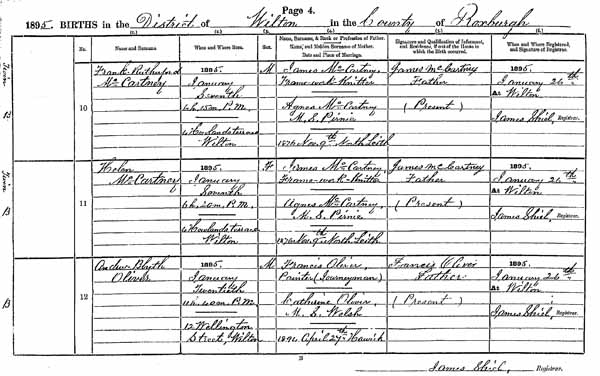Statutory Register of Births
Statutory Register of Births
The Statutory Register of Births contains detailed information about every child born in Scotland since 1 January 1855 and is of great value to researchers. This guide covers:
- Information recorded in the registers
- Time of birth
- Use of the term illegitimate
- Transcribed entries
- Vaccination
Information Recorded in the Registers
Most records include:
- name and surname of the child
- where born
- date and time of birth
- sex
- name, surname and occupation of father
- name and maiden surname of mother
- date and place of the parents' marriage
- signature, address (if not the place of birth) and relation of informant
- signature of registrar.
For 1855 only information about the parents’ other children (living or dead) and the ages and birthplaces of both parents was included.
Time of Birth
Time of birth is recorded on all Scottish entries. English, Welsh and Irish records only include time of birth for twins or multiple births. In this example from the registration district of Wilton the registrar has written twin in the left-hand margin of the page against the first two entries but all three entries show the time of birth. The B stands for burgh. Other entries in this register volume have L for the landward or rural part of the district.

Use of the Term Illegitimate
The use of the term “illegitimate” in column one of the birth and death registers was discontinued after 1918. The Registrar General for Scotland issued guidance to registrars that it should no longer be used for new entries. For pre-1919 records an official extract (or certificate) of a birth or death entry that contained the term had to be typed and “illegitimate” omitted. It remains in the register entry which can be viewed as a digital image if the record is over 100 years old.
Transcribed Entries
If there are two entries for a birth it usually means that the child was born in a registration district that was different to the one where its parents usually lived. In these cases the birth was registered in the district where the child was born. The registrar then had to send a copy of the entry to the registrar in the district of the parents’ usual residence within eight days. The details were then transcribed into that register. The Registration of Births, Deaths and Marriages (Scotland) (Amendment) Act 1934 dispensed with these transcript entries.
If you order an official extract (or birth certificate) it will be from the original register entry, that is, the one recorded in the registration district where the child was born.
Vaccination
Registrars issued notices ‘of the requirement of vaccination’ to each informant of a birth. The child had to be vaccinated within six months by a registered medical practitioner. Registrars kept a “vaccination” birth register to record if a child was successfully vaccinated, died before vaccination or was insusceptible (unable to be vaccinated). They also kept a separate register of postponed vaccinations and a list of defaulters.
Section 26(5) of the National Health Service (Scotland) Act 1947 provided that vaccination of children should no longer be compulsory on or after 5 July 1948. Registrars were instructed by the Registrar General not to record details from vaccination certificates lodged after that date unless the child was born and registered before 5 July 1948.